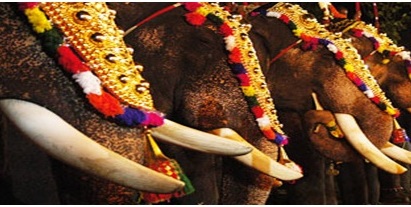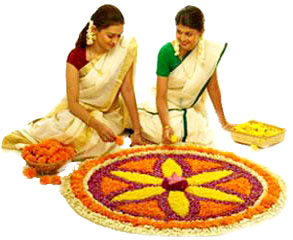People in diffrent religion are living in perfect harmony here and they take part in festivals irrespective of religious differences.There are a lot many Hindus participating in the festivals of Christians nad Muslims and similarly there Christians and Muslims taking initiative to enrich festivals in temples.
Among the innumerable festivals that take place all over Kerala, almost all the prominent ones are connected with religious institutions. The Utsavas of the Hindu temples and the Perunals of Christians and Muslim are of utmost importance to the community.There are certain festivities like the boat races, which originated to commemorate religious events but subsequently turned out to be events of social importance. Kathakali, Ottan thullal , Kathaprasangam, Sangeetha kacheri, Dance , Drama, Kuthiyottam, Garudan thookkam, Nedumkuthirayeduppu and Kampam were the main attractions during the temple celebrations.
Packed with fun and excitement, festivals are occasions to clean and decorate houses, to get together with friends and relatives.
Elephant Festival - Gajamela
 No celebration in Paravur is complete without an elephant pageant. The gentle giant has been revered like divinity and accorded the privilege of escorting the numerous gods and goddesses of this land. Almost every festivals of temples are accompanied by elephants.These are the best occasions to watch the majestic tuskers in all their caparisoned splendour.Colourfully decked up elephants numbering fifteen to hundred or more line up on the temple premises with nettippattom. (The glittering ornament that adorns the forehead of the elephant, crafted in gold by a skilled clan of artisans.) With mahouts atop them, holding high tinselled silk parasols (muthukuda) and swaying white tufts (venchamaram) and peacock feather fans (aalavattom) to the rhythm of the temple orchestra.An elephant pageant is usually accompanied by the Panchavadyam (the traditional five instrument musical ensemble) The prominent among these is held at Puttingal Temple at the time of temple festival 'Meenabharani'(March -April).The Elephant Festival in paravur has become a major draw for the tourists during their travel and tour.
No celebration in Paravur is complete without an elephant pageant. The gentle giant has been revered like divinity and accorded the privilege of escorting the numerous gods and goddesses of this land. Almost every festivals of temples are accompanied by elephants.These are the best occasions to watch the majestic tuskers in all their caparisoned splendour.Colourfully decked up elephants numbering fifteen to hundred or more line up on the temple premises with nettippattom. (The glittering ornament that adorns the forehead of the elephant, crafted in gold by a skilled clan of artisans.) With mahouts atop them, holding high tinselled silk parasols (muthukuda) and swaying white tufts (venchamaram) and peacock feather fans (aalavattom) to the rhythm of the temple orchestra.An elephant pageant is usually accompanied by the Panchavadyam (the traditional five instrument musical ensemble) The prominent among these is held at Puttingal Temple at the time of temple festival 'Meenabharani'(March -April).The Elephant Festival in paravur has become a major draw for the tourists during their travel and tour.Fireworks - Kambam
 Kambam or Fireworks is also one of the most important and enthusiastic feast among the festivals of Paravur. On earlier days it was conducted as part of festivals in temples of paravur like -Puttingal Temple , Kuzhikkarathazham Sastha Temple, Puthiyakavu Devi Temple, Valiyavelichazhikom Devi Temple and Kattukulam Subramanyan Temple. Now it is mainly held in every year along with 'Meenabharani ' Festival of Puttingal temple and also along with some other temples nearby. Apart from the native people innumerable tourists also enthusiastically reach here to intensify the quantity of the masses. A tongue of fire snakes and a line of crackers and the crowd’s excited cheers are drowned in blinding explosions. The explosions are of such intensity that, buildings around the place shake and trembles. This great night-time spectacle and all night celebrations with splendid fireworks display is a must of thing to watch.
Kambam or Fireworks is also one of the most important and enthusiastic feast among the festivals of Paravur. On earlier days it was conducted as part of festivals in temples of paravur like -Puttingal Temple , Kuzhikkarathazham Sastha Temple, Puthiyakavu Devi Temple, Valiyavelichazhikom Devi Temple and Kattukulam Subramanyan Temple. Now it is mainly held in every year along with 'Meenabharani ' Festival of Puttingal temple and also along with some other temples nearby. Apart from the native people innumerable tourists also enthusiastically reach here to intensify the quantity of the masses. A tongue of fire snakes and a line of crackers and the crowd’s excited cheers are drowned in blinding explosions. The explosions are of such intensity that, buildings around the place shake and trembles. This great night-time spectacle and all night celebrations with splendid fireworks display is a must of thing to watch.History of fireworks in paravur:-
The fireworks was held by the captians called 'asan'. Some of the famous asan's from paravur who excelled in this feast are Sri Pozhikkara Govindan Asan, Pozhikkara Krishnan Asan , Pozhikkara Narayan Pilai Asan , Kavila Kochuraman Asan, Kavila Balakrishna Pillai Asan, Kavila Gopalakrishna Pillai Asan, Kochethu Raghavan Asan, Pozhikkara Vidyadharan Asan etc. Among these Govindan Asan and Krishnan asan have experienced their skills from Foreign countries like Singapore,Malasia, China and Korea. Both of these got lot of medals from these countries. Govindan Asan got gold medal from Singapore for the best Firework Artsit .The duo has performed their skills in competitions throughout kerala and has defeated most of their rivals of that time. After the trajedy which caused the death of 5 persons and injured around 100's which occured at 1929 , the competition of fireworks was abandoned in Puttingal. It was then revived at 1974 in the same venue by the clash of Puzhikkunnam Govindan Asan and Arjuna Panickar.
The modern fireworks include the so called padakkam, perukkam, kalayam and kutti amittu which comprise of palavarnam, pakari, suryakanti, silver, gundamittu, nilagundu, electric gundu , adukkikketu etc.... All of them together forms a visual fantastic feast in night at paravur.
Onam
 Onam, the harvest festival and the most popular in Kerala is also one major festival enjoyed by each and every people in paravur.
Onam, the harvest festival and the most popular in Kerala is also one major festival enjoyed by each and every people in paravur. About Onam
It brings back nostalgic memories, carried on the wings of folklore, of a bygone Utopian era of prosperity, equality and righteousness, under the golden reign of Mahabali. Year after year, for centuries, the people of Kerala, irrespective of caste, creed or colour, join together to welcome back their vanquished king. The ten-day Onam festival falls in August-September, coinciding with the beginning of the harvest season.
The Festivity
Preparation of a floral carpet called "Athappookkalam" in front of houses, from the first day of 'Atham' to the tenth day of 'Thiruvonam' is part of the festivities, which is a symbolic gesture to welcome King Mahabali.
The Paravur Municipality conducts Tourism Week celebrations in connection with Onam, showcasing the gems of Kerala's culture. Onam resonates with Carnivals, Kathakali, Dance, Music and Feast. Some of the clubs in paravur conduct various cultural-sports activities and games in those days.
Thaipuyam


Thaipuyam in Makaram (January- February) is of course a most sacred day regarding god subramanya when hundreds of Kavadis are brought to different subramanya temples in a ceremonious manner. After observing fast for seven days devotees carry kavadi containing various articles for abhishekam(Milk, ghee, honey, panchamirtatn -a pudding consisting of banana, jaggery, honey etc.) sandal paste etc. according to one's vow. The procession is accompanied by music and drums. In paravur thousands of devotees offering worship move to Kottayakkunu temple where the contents are emptied and offered to the deity as abhishekam.
The benefits that the devotee gains from offering a Kavadi to the Lord are a million fold greater than the little pain that he inflicts upon himself. Generally, people take a vow to offer the Lord a Kavadi for the sake of tiding over a great calamity. Though this might on the face of it appear mercenary, a moment's reflection will reveal that it contains in it the seed for the supreme love for God. The worldly object is achieved, no doubt, and the devotee takes the Kavadi; but after the ceremony he gets so God-intoxicated that his inner spiritual chamber is opened. This is also a method that ultimately leads to the supreme state of devotion.
The Kavadi
The 'Kavadi' varies in shape and size from the simple shape of a street hawker's storehouse (a wooden stick with two baskets at each end, slung across the shoulder) to the costly palanquin structure, profusely flower- bedecked and decoratively interwoven with peacock feathers. In all cases the Kavadi has a good many brass
 bells adorning it and announcing it as the Kavadi-bearer draws it along. As, very often, the Kavadi bearer observes silence; the bells are the only eloquent signs of a Kavadi procession The Kavadi-bearer continues begging until the baskets are full or the avowed quantity is reached, and then offers the Kavadi to the Lord. Some keen devotees undertake to walk barefooted from home to one of the shrines of Lord Muruga, bearing the Kavadi all the way, and collecting materials for the offering.
bells adorning it and announcing it as the Kavadi-bearer draws it along. As, very often, the Kavadi bearer observes silence; the bells are the only eloquent signs of a Kavadi procession The Kavadi-bearer continues begging until the baskets are full or the avowed quantity is reached, and then offers the Kavadi to the Lord. Some keen devotees undertake to walk barefooted from home to one of the shrines of Lord Muruga, bearing the Kavadi all the way, and collecting materials for the offering.


